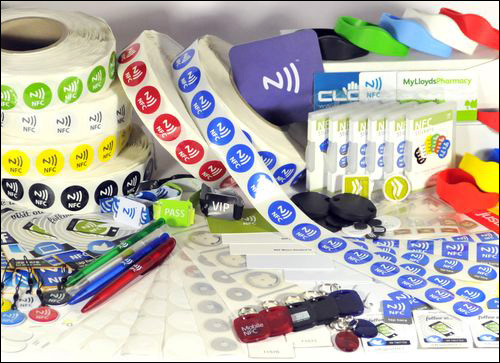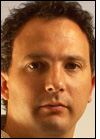The goal of delivering Near Field Communication (NFC) RFID readers into the hands of nearly every individual (provided he or she owns an NFC-enabled smartphone) is prompting a wide variety of creative ideas among businesses. Solutions that provide information to people in parks, bars, conference or meeting rooms, and bus stops are just one application. Some companies currently provide access control using pens containing NFC RFID tags, enabling Wi-Fi access via NFC-tagged beer mats, and also install smart posters in stairwells in order to motivate employees to use stairs instead of elevators.
One distributor that is meeting this market’s demands is RapidNFC, which sells tags and products containing NFC RFID inlays, as well as starter packs—comprising an assortment of RFID-enabled stickers, hangtags, wristbands and key fobs—to firms wishing to try the technology for their own use case. Over the course of the past year, the London-based startup has evolved from selling a few dozen samples each month to hundreds of thousands of tags during the same time period. That growth, says Phil Coote, the company’s CEO, points to the expected abundance of NFC technology in mobile phones throughout the United Kingdom and worldwide. Initial sales were made to “techies” interested in testing the technology for the first time, but the customer base quickly transformed to marketing firms, as well as other large entities.

During the 12-month period in which it has been operating, Coote believes the company—his fourth—has become one of the highest-volume NFC tag providers in the United Kingdom. He has a background in business startups, in the area of online advertising and Web-hosting. Prior to launching RapidNFC, he says, he felt that “NFC seemed extremely exciting.” Most of the excitement, he adds, has been elicited by marketing firms. Typically, such firms approach his company with questions and a general concept, indicating a desire to incorporate NFC technology into a product or a location, and to enable consumers to access data or proceed directly to a Web site to be connected with promotional materials via their mobile phones.
Not all of RapidNFC’s customers, however, are marketers. For example, South Downs Way National Trail, in southern England, has attached NFC tags to signposts in order to provide hikers with access to links to YouTube videos, pictures, audio commentary and information regarding the area’s history and wildlife. Each tag has a printed QR code and an embedded NFC chip. Those carrying an NFC-enabled phone can tap it against the tag and be linked directly to a URL that provides the appropriate data options for that location. By using the tags, the park is able to provide data to hikers without having to install large signage or display panels.
Other NFC solution providers using RapidNFC’s products include pub or bar owners who supply the tags to patrons, enabling them to easily log onto an establishment’s Wi-Fi network. Downloading an app, and then tapping the phone against the tag, causes the NFC reader in the user’s phone to capture the ID number, thereby changing the phone’s settings. “We have a lot of customers doing this,” Coote states. In one common scenario, a user might have an NFC tag attached to his or her desk. Upon arriving at the office, the worker would tap the tag to put the phone on silent mode, turn Wi-Fi on or off, or deactivate the Bluetooth connection. Applications allow a user to tap his or her NFC tag in order to connect to Wi-Fi.
An unnamed RapidNFC customer is providing NFC smart posters to its clients, to be mounted in stairwells to boost staff physical fitness. A unique ID number on each poster links to the location data on a server. Employees who opt to take the stairs (rather than the elevator) proceed up or down the steps, tapping posters along the away with their mobile phones, and thus collecting credit. The companies have the option of then providing rewards to those who frequently use the stairs, rather than the elevator. Not only is the solution “good for health,” Coote says, but “apparently, companies love it because it lowers their carbon emissions by using less electricity.”
RapidNFC sells the tags, or products such as beer coasters, pens, wristbands or other products with embedded NFC tags. Most customers, however, require more than just tags, and RapidNFC, which may serve as the starting point for such companies, has developed relationships with software firms around the world, to which it directs customers so they can obtain advice regarding how their specific NFC-based concepts might be realized.
“A lot of companies are still in the testing or development stages,” Coote says. RapidNFC provides starter kits consisting of tagged wristbands and key fobs, starting at £11.25 ($17.65), as well as a selection of plain NFC tags.
All products that RapidNFC provides contain NXP Semiconductors chips, most commonly the NTag203 model, released in 2011.
For first-time NFC users, RapidNFC also offers advice, some of which is posted on the company’s Web site, indicating how to encode a tag. Coote says he is often asked about the use of RFID tags in items such as business cards with data written on the tag. He doesn’t encourage this application, he notes, adding, “We strongly promote the fact that NFC tags are intended to link the user to data rather than being data themselves.” The problem with writing data to the tag itself, he explains, is that “you are limited to the type of tags you can use to store static data, and you’re breaking the principle that NFC is a link.”
According to Coote, the amount of growth experienced by NFC technology during the next 12 months may, in some ways, depend on Apple, and on whether the iPhone maker builds NFC functionality into its latest products. To date, unlike Microsoft Windows-based or Android-based smartphones, the iPhone does not come with a built-in NFC reader. However, he notes, “The marketing people we’re speaking to don’t seem to care. They’re happy to just go ahead,” and provide the solution to Android-based phone owners. “QR codes will still be there to cover the iPhone situation.” Throughout the next 12 months, he anticipates, growth will be very fast, “and if Apple comes on board, it will be even faster.”


